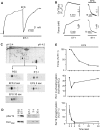New insights into myosin phosphorylation during cyclic nucleotide-mediated smooth muscle relaxation
- PMID: 22711245
- PMCID: PMC3521644
- DOI: 10.1007/s10974-012-9306-9
New insights into myosin phosphorylation during cyclic nucleotide-mediated smooth muscle relaxation
Abstract
Nitrovasodilators and agonists, via an increase in intracellular cyclic nucleotide levels, can induce smooth muscle relaxation without a concomitant decrease in phosphorylation of the regulatory light chains (RLC) of myosin. However, since cyclic nucleotide-induced relaxation is associated with a decrease in intracellular [Ca(2+)], and hence, a decreased activity of MLCK, we tested the hypothesis that the site responsible for the elevated RLC phosphorylation is not Ser19. Smooth muscle strips from gastric fundus were isometrically contracted with ET-1 which induced an increase in monophosphorylation from 9 ± 1 % under resting conditions (PSS) to 36 ± 1 % determined with 2D-PAGE. Electric field stimulation induced a rapid, largely NO-mediated relaxation with a half time of 8 s, which was associated with an initial decline in RLC phosphorylation to 18 % within 2 s and a rebound to 34 % after 30 s whereas relaxation was sustained. In contrast, phosphorylation of RLC at Ser19 probed with phosphospecific antibodies declined in parallel with force. LC/MS and western blot analysis with phosphospecific antibodies against monophosphorylated Thr18 indicate that Thr18 is significantly monophosphorylated during sustained relaxation. We therefore suggest that (i) monophosphorylation of Thr18 rather than Ser19 is responsible for the phosphorylation rebound during sustained EFS-induced relaxation of mouse gastric fundus, and (ii) that relaxation can be ascribed to dephosphorylation of Ser19, the site considered to be responsible for regulation of smooth muscle tone.
Figures



References
-
- Arner A, Pfitzer G. Regulation of cross-bridge cycling by Ca2+ in smooth muscle. Rev Physiol Biochem Pharmacol. 1999;134:63–146. - PubMed
-
- Bárány K, Bárány M. Myosin light chains. In: Bárány M, editor. Biochemistry of smooth muscle contraction. San Diego: Academic Press; 1996. pp. 21–35.
-
- Bárány M, Bárány K. Protein phosphorylation during contraction and relaxation. In: Bárány M, editor. Biochemistry of smooth muscle contraction. San Diego: Academic Press; 1996. pp. 321–339.
Publication types
MeSH terms
Substances
LinkOut - more resources
Full Text Sources
Miscellaneous

